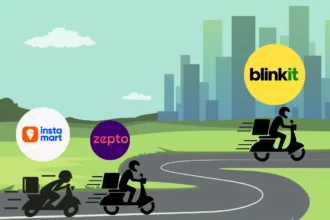Estimated Reading Time: 22-26 minutes ( 4,480 words)
Introduction
Turning 30 is a major milestone—and for many young adults, it’s also a financial checkpoint. Imagine entering your 30s with a solid ₹10 lakh (1 million INR) foundation already saved and invested. That single milestone can change the trajectory of your wealth, giving you confidence, freedom, and a head start compared to 80% of young earners in India who, according to surveys by ET Money and YouGov, save less than 20% of their income in their 20s. While ₹10 lakh may sound ambitious, the truth is that with a clear plan, small consistent contributions, and smart financial choices, this goal becomes not just achievable, but surprisingly realistic.
What makes this even more powerful is the timing: your 20s are the decade where compounding works like magic, your responsibilities are relatively low, and your career growth is at its sharpest. Whether you’re a fresh graduate earning ₹25,000 per month, a tech professional making ₹60,000, or someone balancing gigs, freelance work, or early-stage business income, the right roadmap can help you save aggressively without sacrificing a good lifestyle. You don’t need big money—you need early money, automated money, and disciplined money.
In this guide, you’ll get a practical, data-backed savings blueprint that adapts to every income level. I’ll break down exactly how much you need to save each month, how long it takes to hit ₹10 lakh, and what investment vehicles (SIPs, index funds, recurring deposits, high-yield accounts) work best at different risk levels. You’ll also get behavioral hacks to avoid lifestyle inflation, smart budgeting frameworks, risk-management essentials, and real-life examples from Indians who cracked the ₹10 lakh milestone before 30. No fluff, no unrealistic hacks—just a clear, actionable plan to build wealth in your 20s.

Why ₹10 Lakh by 30 Is a Powerful Goal (Detailed & Data-Backed)
1.1 The Compounding Advantage in Your 20s
Building a ₹10 lakh corpus before turning 30 taps directly into the single biggest financial advantage young people have: time. With even a modest investment horizon of 5–10 years, compounding turns small monthly contributions into significant long-term wealth.
For example, investing just ₹10,000/month at 12% returns in an equity mutual fund SIP grows to:
- ₹8.3 lakh in 5 years
- ₹23.4 lakh in 10 years
This means the ₹10 lakh milestone is not dependent on high income—it’s dependent on early, consistent investing. The earlier you start, the less you have to contribute to reach the same goal. Your 20s offer this window.
1.2 A Financial Cushion That Changes Life Decisions
A ₹10 lakh corpus (~USD $12,000 globally) creates a powerful buffer against uncertainty—something most young adults underestimate. It can serve as:
- An emergency fund covering 6–12 months of expenses
- A down-payment starter for a car or home
- Seed capital for freelancing, upskilling, or a business
- A safety net during career changes or layoffs
In a world where job volatility is rising and cost of living is unpredictable, having ₹10 lakh before 30 dramatically increases financial confidence and reduces dependency on loans or family support.
1.3 A Behavioral Milestone That Builds Lifelong Discipline
More than the money, the journey to ₹10 lakh trains the habits that make you wealthy in your 30s and 40s. Setting a concrete, measurable goal drives intentional spending, focusing on priorities, avoiding debt traps, and building consistency. Behavioral economists emphasize that consistent monthly investing has a stronger long-term impact than occasional big contributions.
Once you hit your first ₹10 lakh, your mind rewires—you understand compounding, you prioritize investing automatically, and you begin to see money as a tool, not a stressor.
1.4 Rising Retail Investing Culture in India
India is experiencing a historic shift in personal finance behavior. Young Indians, especially Gen Z and early millennials, are investing earlier than ever.
According to AMFI’s March 2025 report, India’s SIP (Systematic Investment Plan) assets under management reached a record ₹13.35 lakh crore—a sign of widespread trust in mutual funds as a long-term wealth vehicle.
Monthly SIP inflows crossed ₹19,000 crore, driven largely by 20–35-year-olds. This means the market environment is supportive: tools, platforms, educational content, and financial awareness are all better than at any point in the last decade.
1.5 Favorable Inflation and Economic Tailwinds
Inflation directly affects savings, and India’s recent numbers show a positive trend. As of March 2025, India’s CPI inflation moderated to 3.34%, according to data from the Ministry of Statistics & Programme Implementation.
Lower inflation means:
- Your savings retain more real value
- Investment returns have higher real growth
Living costs rise slower, making it easier to save more
Additionally, rising median incomes, fintech adoption, growth in gig work, and demand for skilled roles in tech, finance, and healthcare make the next decade extremely promising for young earners.
Key Financial Assumptions & Risks (Detailed & Data-Backed)
Before creating a roadmap to save ₹10 lakh before 30, it’s important to define the assumptions driving the plan and understand the risks that could delay or derail your goal. These assumptions help set realistic expectations, while the risks highlight what you must actively guard against.
2.1 Key Financial Assumptions
Assumption 1: 8–12% Annualized Returns via SIPs
The roadmap assumes an average annualized return of 8–12%, which is realistic for:
- Equity mutual funds (historical average: 10–14% over 10–15 years)
- Index funds (Nifty 50 CAGR for last 15 years ~12%)
- Balanced or hybrid funds (7–10% range)
This builds a conservative yet achievable return expectation. While some years could see 20%+ growth and some years negative returns, over 5–10 years, equity SIPs tend to deliver stable annualized returns within this band.
Example:
₹12,000 per month at 12% CAGR = ₹10 lakh in ~5.7 years.
Assumption 2: Monthly Saving Capacity Depends on Income Level
Your ability to save depends on your net income. Typical scenarios for Indian earners:
- Earning ₹25,000–35,000/month → Savings target: ₹5,000–7,000
- Earning ₹40,000–60,000/month → Savings target: ₹8,000–15,000
- Earning ₹70,000–1,00,000+/month → Savings target: ₹15,000–25,000+
The roadmap assumes you maintain at least 20–30% savings rate, which is recommended by financial planners for individuals in their 20s.
Assumption 3: You Stay Invested Despite Volatility
A critical assumption is that you do not stop SIPs during market corrections. Historically, markets recover strongly after downturns.
Example:
- 2020 crash → Nifty 50 fell 38%, recovered fully in 7 months
- 2022 correction → Market recovered in 2023–24
Those who continued SIPs during volatility earned higher long-term returns because they bought more units at lower prices.
Assumption 4: Basic Financial Hygiene Is Followed
This includes:
- No high-interest loans (credit cards, BNPL)
- Having an emergency fund of 2–3 months expenses
- Not withdrawing investments prematurely
- Increasing SIPs annually as income grows
These behaviors ensure that your savings goal stays on track.
2.2 Key Risks That Can Impact Your ₹10 Lakh Goal
Risk 1: Inflation Risk
Inflation reduces the purchasing power of your money. Even if you save ₹10 lakh, the real value may be lower if inflation is high.
As per RBI’s FY25 estimate, CPI inflation was projected at 4.8% (Times of India). India’s inflation is volatile due to fuel prices, food supply, and global macro factors.
Mitigation:
- Keep most long-term savings in equity (beats inflation).
- Increase SIPs annually by 10–15%.
- Maintain a portion in liquid or ultra-short funds for safety.
Risk 2: Market Risk
Equity markets fluctuate — sometimes severely. Drawdowns of 10–30% are normal within short periods.
Example:
- Covid crash (2020): –38%
- 2008 financial crisis: –52%
Mitigation: - Stay invested during downturns.
- Use hybrid or index funds if risk tolerance is low.
- Avoid checking your portfolio daily.
Risk 3: Behavioral Risk (The Biggest Threat)
Data shows that most SIPs fail not because of markets but because people stop contributions. Common behavioral pitfalls:
- Overspending due to lifestyle inflation
- Pausing SIPs after layoffs or emotional decisions
- Withdrawing SIPs to fund vacations or gadgets
- Falling into BNPL/credit card debt cycles
Behavior risk can set your goal back by years.
Mitigation:
- Automate SIPs on salary day
- Use budgeting apps
- Follow a 24-hour rule for impulsive purchases
- Keep a separate emergency fund
Risk 4: Liquidity Risk
If you lock too much money in long-term investments (equity funds, ELSS, retirement plans) without adequate liquid savings, you may be forced to redeem prematurely during emergencies.
Mitigation:
- Maintain 3–6 months of expenses in liquid instruments
- Use a 70:20:10 model → Long-term : Short-term : Emergency
Risk 5: Income Instability (Gig & Early Career Workers)
Many young professionals in India have variable income (freelancing, gig work, sales roles). Unpredictable income can lead to inconsistent saving habits.
Mitigation:
- Set a minimum SIP amount + variable top-up SIPs
- Save more aggressively in high-income months
Step-by-Step Roadmap to Save ₹10 Lakh
Saving ₹10 lakh before 30 isn’t just about cutting expenses — it’s a structured process that blends budgeting, automation, smart investments, and disciplined behavior. This roadmap breaks it down into simple, actionable steps you can start today.
Step 1: Assess Your Income & Expenses (Your Financial Baseline)
Most people underestimate their expenses and overestimate their saving ability. The first step is to organize your money flow clearly.
✔ Track Your Cash Flow
Use any method that keeps you consistent:
- Google Sheets (create monthly budget tracker)
- Apps like Walnut, Jupiter Money, Money View, CRED, Fi
- Manual notebook budgeting
Track for 30 days and categorize every rupee you spend.
✔ Segment Your Expenses
Break spending into three buckets:
- Fixed expenses: rent, EMIs, utilities, insurance
- Variable essentials: groceries, commute, mobile recharge
- Discretionary: travel, dining out, online shopping, subscriptions
This breakdown helps identify leaks—many young Indians spend 15–25% of income on food delivery & impulse buys.
✔ Set a Savings Rate
A realistic target for someone in their 20s is:
- Start with 20% of take-home pay
- Increase gradually to 30–40%
Example:
If you earn ₹40,000/month, saving 25% gives you ₹10,000 monthly — enough to hit ₹10 lakh in 7 years with disciplined SIPs.
Step 2: Build an Emergency Fund (Your Safety Net)
Before aggressive investing begins, create financial protection.
✔ Why You Need This
Without an emergency fund, you may stop SIPs or redeem investments during a crisis—setting your 10-lakh goal back by years.
✔ How Much to Save
Aim for 3–6 months of essential expenses, stored in liquid instruments like:
- High-yield savings accounts
- Liquid mutual funds
- Ultra-short duration funds
- Sweep-in FD accounts
✔ Best Practice
Start by saving ₹2,000–₹4,000/month before scaling SIPs. Once the emergency fund is full, redirect the entire amount to investments.
Step 3: Automate Your Savings (The Wealth-Amplifying Habit)
Automation removes emotional decisions and ensures consistency — the #1 predictor of SIP success.
✔ Set Up Automatic Transfers
On payday:
- Use UPI AutoPay, standing instructions, or bank auto-debits
- Transfer directly into your SIP account or secondary savings account
This follows the principle: “Invest first, spend what’s left.”
✔ Create Rule-Based Saving Habits
Increase your savings as income grows:
- Save 50% of every bonus
- Increase SIP by 10% every year
- Round-up savings: If you spend ₹180, round up to ₹200 and save ₹20
These “micro-habits” compound just like money does.
✔ Why It Works
Studies in behavioral finance show automation increases long-term savings by 40–60%, especially for young adults.
Step 4: Use SIPs (Systematic Investment Plans) to Hit ₹10 Lakh
SIPs are the engine of your 10-lakh goal. They provide disciplined investing without requiring market timing.
✔ Choose the Right Asset Mix
Your risk tolerance determines the allocation:
- High risk (ages 20–30): 80% equity, 20% hybrid
- Moderate risk: 60% equity, 40% hybrid
- Low risk: 40% equity, 60% hybrid/debt
For a 7–10-year timeline, an equity-heavy mix is recommended.

✔ Calculate the Required SIP Amount
Using a 10% expected return, here are sample SIP targets:
| Starting Age | Years to 30 | Monthly SIP (10% Return) |
| 20 | 10 years | ₹6,000–7,000 |
| 23 | 7 years | ₹9,000–11,000 |
| 25 | 5 years | ₹15,000–18,000 |
| 27 | 3 years | ₹25,000–28,000 |
(Actual numbers depend on calculators and chosen funds)
✔ Stay Consistent — Even in Market Crashes
History shows the best returns often come after corrections.
Example:
- If you continued SIPs after the 2020 crash, your long-term returns increased.
- Stopping SIPs during downturns reduces wealth by 15–20% over time.
✔ Use SIP Top-Ups
Top-up SIPs by 10–20% annually to reach your goal faster with minimal effort.
Step 5: Invest Tax-Smart to Boost Real Returns
Taxes reduce your final wealth, so using smart tax planning accelerates the ₹10 lakh milestone.
✔ Use ELSS (Equity-Linked Saving Schemes)
Benefits:
- ₹1.5 lakh deduction under Section 80C
- Only 3-year lock-in (shortest among tax-saving instruments)
- Equity exposure helps beat inflation
✔ Compare Other Tax-Saving Tools
- Public Provident Fund (PPF)
- National Pension System (NPS)
- Tax-saving FDs (lower returns but stable)
- Insurance (avoid unless for protection, not investment)
✔ Rebalance Your Portfolio Annually
Once a year, adjust your asset allocation:
- Shift gains from equity to hybrid/debt as you near your goal
- Exit high-risk funds closer to the final year
This protects the accumulated corpus and reduces volatility risks.
Behavioral Hacks to Accelerate Your Saving
Most people fail to save not because of low income, but because of behavioral patterns—impulse spending, lack of structure, emotional decisions, and peer influence. These simple psychological hacks help you stay disciplined and reach ₹10 lakh faster by making saving easier, automatic, and rewarding.
4.1 Set Sub-Goals (Break Big Goals Into Manageable Wins)
A ₹10 lakh target feels huge when you’re just starting. Breaking it into smaller milestones reduces overwhelm and increases motivation.
Example Breakdown:
- Year 1–2: Hit ₹2 lakh
- Year 3–4: Grow to ₹5 lakh
- Year 5–7: Reach ₹10 lakh
Why this works:
- Behavioral science shows that frequent wins increase dopamine, making long-term goals fun and sticky.
- You can track progress every quarter instead of waiting years.
- Smaller milestones help you course-correct faster.
4.2 Gamify Your Saving (Make It Fun, Not Painful)
Turning saving into a challenge makes the process exciting rather than restrictive.
Popular gamified methods:
- 52-Week Savings Challenge: Increase your savings by ₹100 each week (Week 1 = ₹100, Week 2 = ₹200… Week 52 = ₹5,200).
- No-Spend Weekend Challenge: Choose 2–3 weekends per month with zero discretionary spending.
- Round-Up Method: If something costs ₹365, round up to ₹400 and save ₹35.
- Spend-Match Method: Buy something for ₹500? Save ₹500 too.
Gamification transforms saving from a chore into a personal competition.
4.3 Use Visualization Tools (Make Your Goals Visible)
Humans save better when they see progress.
Effective visualization methods:
- A Google Sheets dashboard with graphs of:
- Monthly savings
- SIP growth
- Progress % toward ₹10 lakh
- Monthly savings
- A physical tracker on your wall with boxes you fill as you save
- A goal thermometer chart (common in budgeting communities)
Why it works:
Visual cues create emotional attachment. When you literally see your progress, your brain feels rewarded, reinforcing the habit.
4.4 Build a Side Hustle & Route All Extra Money to Savings
Your salary might have a ceiling, but your income does not.
High-ROI side gigs for Indians include:
- Freelancing (writing, editing, design, coding, social media)
- Online tutoring (math, science, English, competitive exams)
- Weekend gig work (Swiggy Genie, Dunzo, deliveries)
- Reselling products on Instagram/Meesho
- Skill-based micro-services (Canva templates, video editing, LinkedIn content)
Rule:
👉 100% of side income goes straight into your investment fund.
This accelerates compounding and shortens your timeline by years.
Example:
Earn ₹8,000/month freelancing → ₹96,000/year extra → ₹6–7 lakh more in 5 years with compounding.
4.5 Get an Accountability Partner (Social Pressure Works)
Money becomes easier to manage when you’re not doing it alone.
Find a friend, colleague, or sibling who also has a financial goal, then:
- Have monthly check-ins together
- Share progress screenshots
- Celebrate milestones
- Review mistakes or overspending
This creates positive peer pressure and keeps you consistent.
Research shows that people with accountability partners are 65–95% more likely to hit goals.
4.6 Avoid the Lifestyle Inflation Trap (The Silent Wealth Killer)
When income rises, spending rises even faster for most young adults.
This is known as lifestyle inflation, and it destroys long-term wealth.
Examples of inflation traps:
- Upgrading from bike → car prematurely
- Frequent online shopping
- Eating out more often
- Buying gadgets on EMI
- Moving to a more expensive flat even when not necessary
The Golden Rule:
When you get a raise, save 30–50% of the increment before increasing any lifestyle spending.
Example:
If salary increases from ₹40,000 → ₹50,000, save ₹5,000 extra every month.
This new savings amount compounds massively over 5–10 years.
4.7 Bonus: Create “Friction” for Bad Spending, “Ease” for Good Spending
- Remove saved cards from shopping apps
- Uninstall delivery apps if needed
- Switch to a prepaid wallet for discretionary spending
- Keep investments automated and hard to withdraw
Small friction points reduce impulsive purchases significantly.
Case Studies: Three Realistic Scenarios
Here are three hypothetical but realistic case studies to illustrate how different people can hit the ₹10 Lakh goal.
| Scenario | Income & Saving Rate | Strategy | Estimated Outcome by 30 |
| Entry-level IT professional | ₹40,000/month, saves 25% = ₹10,000 | Emergency fund + SIP in equity fund | ~₹10 Lakh in ~6.5–7 years (if 10% return) |
| Mid-tier sales associate | ₹60,000/month, saves 20% = ₹12,000 | Balanced fund + side hustle contribution | ~₹10 Lakh in ~5–6 years |
| Gig-worker / Freelancer | Variable income, average ₹50,000, saves 30% = ₹15,000 when earning | Build buffer, then SIP aggressively | ~₹10 Lakh in ~5 years (with compounding) |
Lessons from these:
- Even modest monthly savings, invested wisely, compound meaningfully.
- Side income accelerates the goal.
- Consistency and discipline matter more than timing the market.
Risks to Be Aware Of & How to Mitigate Them
Risk #1: Stopping SIPs when income dips or expenses spike
- Mitigation: Maintain the emergency fund; pause but don’t cancel SIPs.
Risk #2: Poor fund selection
- Mitigation: Choose funds with good track records, low expense ratios, and align with your time horizon.
- Consider passive / index funds for long-term growth.
Risk #3: Inflation eroding real value
- Mitigation: Choose equity- or hybrid-based investments that historically beat inflation.
- Revisit and revise your goal in real terms (adjust for inflation every year).
Risk #4: Emotional investing during market crashes
- Mitigation: Automate investments, set alerts but don’t react emotionally.
- Remember: SIPs are meant to benefit from rupee-cost averaging.
Tools, Calculators & Lead Magnet Ideas
- SIP Calculator: Embed or link to an interactive calculator (e.g., Google Sheets or web-based).
- Budget Template: Provide a downloadable monthly budget Excel / Google Sheet template.
- Goal Tracker PDF: A printable “₹10 Lakh by 30” progress tracker.
- Email Lead Magnet: “7-Year Savings Planner” — a PDF + spreadsheet that helps calculate monthly SIP, emergency fund, side income allocation, and rebalancing.
FAQs Section
1. Is ₹10 lakh before 30 a realistic goal for everyone?
Yes — for a large majority of young earners, it’s achievable, but the effort required varies based on income level, age, and lifestyle.
Why it’s realistic:
- Most people in their early 20s experience steady salary growth, allowing for increasing SIP contributions over time.
- Even small SIPs (₹5,000–₹10,000 monthly) compound meaningfully over 7–10 years.
- Many urban professionals already spend ₹3,000–₹10,000 monthly on non-essential items that can be redirected toward savings without major lifestyle sacrifice.
- Freelancers or gig workers often have variable income but higher upside, enabling occasional lump-sum investments.
What makes it difficult for some:
- High living costs, especially in Tier-1 cities
- Lack of budgeting discipline
- Inconsistent income without safety cushions
- Family responsibilities or education loans
If you fall in these categories, you can still hit the number by:
- Increasing earning power
- Cutting discretionary expenses
- Extending the timeline slightly
- Using side-income sources
Most people reach ₹10 lakh not because their salary is high, but because their habits are strong.
2. What type of fund should I use to save?
Choosing the right fund determines your growth trajectory.
Types of funds commonly used:
a) Equity Mutual Funds
- Suitable for long-term goals (5+ years)
- Historically deliver 10–12% CAGR
- Include flexi-cap, index funds, large-cap, mid-cap
- Higher volatility but highest wealth creation potential
Best for:
- Early 20s earners
- Anyone comfortable with short-term fluctuations
b) Hybrid Mutual Funds
- Mix of equity (35–75%) and debt
- Reduce downside during market crashes
- Typically 7–10% returns
Best for:
- New investors
- People with moderate risk tolerance
- People nearing the target timeline (age 27–29)
c) Debt Funds
- Stable and low-risk
- Returns 5–7%
- Great for emergency fund, short-term parking, or diversification
Not ideal as the primary driver for ₹10 lakh unless you invest a larger monthly amount.
3. Can debt funds help me reach ₹10 lakh?
Yes, but with limitations:
How debt funds can help:
- Protect capital
- Reduce volatility
- Useful for temporary parking of money before moving into SIPs
- Help create the safety net needed to stay invested in equity
- Suitable for risk-averse individuals needing predictable income
Limitations:
- Returns are lower → You’ll need to invest more every month
- Inflation can outpace debt fund returns
- Won’t help you hit the ₹10 lakh goal quickly unless combined with equity
A practical approach:
50–70% Equity
20–40% Hybrid
10–20% Debt (for cushion)
4. What happens if I miss a SIP payment?
Good news: You’re never penalized.
If your bank balance is low or you miss a month, nothing negative happens:
- The SIP doesn’t get cancelled (unless repeatedly failed)
- Your existing investments remain safe
- NAV calculation continues as usual
What you should do:
- Resume next month
- If possible, make a manual lump-sum equivalent to missed SIP
- Reassess your monthly budget to avoid repeated skips
Why consistency matters:
Skipping SIPs reduces the total number of investment months — which weakens the compounding effect.
But a few misses across years won’t significantly impact your goal.
5. Should I use ELSS or PPF for this goal?
Understanding ELSS (Equity Linked Savings Scheme):
- 3-year lock-in
- Part of Section 80C tax-saving bucket
- Equity-based, high-growth potential
- Shortest lock-in among tax-saving options
Good if:
✔ You want tax benefits
✔ Your risk tolerance is medium-high
✔ You want to stay invested long-term
Understanding PPF (Public Provident Fund):
- 15-year lock-in
- Government-backed, guaranteed return
- Annual limit: ₹1.5 lakh
Best for:
✔ Conservative investors
✔ Long-term goals (retirement)
✔ Tax-free maturity
Which is better for the ₹10 lakh goal?
- ELSS: Suitable if you want growth + tax benefits
- PPF: Not ideal for a <10-year goal unless you already contribute for long-term wealth creation
Most people choose ELSS as part of the strategy — not the entire strategy.
6. How often should I review my investments?
Once a year is perfect.
Any more than that, and emotions start influencing decisions.
Annual review checklist:
- Did your asset allocation (equity vs debt) drift by 10–20%?
- Did your SIP amount increase with your salary?
- Are you on track with your ₹10 lakh timeline?
- Any major life changes (job shift, marriage, relocation) that impact saving capacity?
- Should you rebalance:
- Sell some equity when markets overperform
- Buy equity when markets underperform
- Sell some equity when markets overperform
Avoid reviewing monthly:
- Markets fluctuate constantly
- Short-term fear leads to bad decisions
- Over-monitoring reduces discipline
7. What if inflation becomes very high?
Why inflation matters:
Higher inflation reduces the real value of your ₹10 lakh.
For example:
If inflation is 7%, your ₹10 lakh is worth ~₹7 lakh in real terms after a few years.
How to adapt:
- Increase your SIP amount annually by 5–15%
- Shift more allocation to equity (long-term inflation-beating asset)
- Reduce cash sitting idle
- Cut discretionary spending temporarily
- Boost income through side hustles or skill upgrades
Inflation is a silent enemy — but consistent investing defeats it.
8. Is it okay to liquidate part of my lump sum before age 30?
You can, but it’s risky.
Each withdrawal:
- Breaks compounding
- Resets your progress
- Makes your target harder to achieve
Only withdraw in these cases:
- Medical emergency
- Job loss after exhausting emergency fund
- Family crisis
- Unexpected large expenses you cannot delay
Never withdraw for:
✘ Vacations
✘ Gadgets / lifestyle purchases
✘ Weddings of friends
✘ Car down payments (unless planned)
If you expect these needs, create separate short-term buckets.
9. Can I combine this plan with a side hustle?
Absolutely — this is the biggest accelerator.
Best side hustles for young professionals:
- Freelancing (design, writing, programming)
- Online tutoring
- Digital services (SEO, social media management)
- Weekend gig work (delivery, event support)
- Video editing, content creation
- Selling digital products
Strategy:
- Direct 100% of side-income into your investment plan
- Treat it as “invisible income”
- You can shave 1–2 years off your goal easily
Many young Indians reach ₹10–15 lakh before 30 primarily through side income + SIP discipline.
10. Do I need a financial advisor?
You don’t need one — but it can help in certain situations.
When you don’t need an advisor:
- Your only goal is ₹10 lakh
- You are comfortable with basic investing apps
- You prefer index funds, hybrid funds, and simple SIPs
- You review investments annually
When you should consider one:
- You earn a high salary and want tax optimization
- You have multiple goals (house, marriage, car, retirement)
- You aren’t confident selecting funds
- Market swings influence your emotions
- You want personalized asset allocation advice
A good advisor offers clarity, discipline, and risk management — but a simple ₹10 lakh goal is absolutely achievable without one.
Summary
- Saving ₹10 lakhs before 30 is achievable for most young professionals in India with the right mix of early investing, income growth, and controlled lifestyle spending.
- The magic formula is: start early + automate investing + avoid high-interest debt + grow income aggressively.
- Investing ₹10,000–₹15,000/month in equity mutual funds or index funds can realistically grow to ₹10 lakhs in 5–7 years, thanks to compounding.
- Cutting lifestyle leaks—food delivery, subscriptions, credit card EMIs—can free up ₹5,000–₹12,000/month instantly.
- Side hustles (freelancing, content creation, teaching, resale) can add ₹8,000–₹50,000/month, speeding up savings dramatically.
- Health insurance, emergency funds, and debt elimination prevent setbacks that commonly derail savings goals for people in their 20s.
- A combination of 50/30/20 budgeting + SIPs + consistent skill upgrading ensures long-term financial momentum.
- Tracking money weekly makes your financial behaviour shift automatically—what gets measured improves.
- Avoid common traps: lifestyle inflation, unnecessary EMIs, zero savings months, and aggressive trading.
- With discipline and a structured strategy, hitting ₹10 lakhs by 30 is not just possible—it’s predictable.

Conclusion
Hitting ₹10 lakhs in savings before you turn 30 is far more than a financial checkpoint—it’s the foundation of lifelong wealth-building. This milestone represents stability, confidence, and the ability to take life decisions from a place of security rather than fear. The roadmap you’ve just gone through doesn’t rely on extraordinary income, aggressive trading, or luck. It’s built on fundamentals: consistent SIPs, controlled spending, disciplined budgeting, and a realistic understanding of how money grows over time. When you follow this structure, you’re not just accumulating money—you’re developing the mindset, systems, and habits that separate financially strong individuals from those who constantly feel behind.
What often surprises people is just how powerful compounding becomes when you start in your early 20s. Even modest monthly contributions snowball when given the gift of time, transforming routine savings into meaningful wealth. The earlier you begin, the less pressure you place on yourself later—and the easier it becomes to stay on track even when life gets busy or unpredictable. Think of your ₹10 lakh target not as a finish line, but as the first major milestone in a much longer wealth-building journey.
Ultimately, the most important step is simply starting now. Whether you’re 22 or 28, employed or freelancing, living in a metro or a Tier-2 city—your financial future improves the moment you decide to automate savings, invest consistently, and avoid lifestyle traps. By committing to this roadmap today, you give yourself a massive head start and unlock a future where money becomes a tool, not a source of stress. And once you hit that ₹10 lakh mark, you’ll realize you’re capable of achieving far bigger goals ahead.
References & Sources
- AMFI Monthly Note, March 2025 – SIP AUM and contributing accounts.
- AMFI Annual Report FY 2025 – Mutual Fund AUM reached ₹65.74 lakh crore.
- RBI / MoSPI Inflation Data – CPI for March 2025 recorded at 3.34%.
- RBI Inflation Projections & Commentary – Monetary policy and FY25 estimates.
- SEBI Investor & Market Participation Reports (2024–2025) – Growth of demat accounts and retail investing trends.
- World Bank Global Savings & Wealth Report (2024) – Insights on global youth saving behavior and household savings.
- OECD Financial Literacy & Wellbeing Study (2024) – Data on financial behavior patterns among young adults.
- Statista Market Insights (2023–2025) – Indian household income, cost-of-living trends, and consumer spending behavior.







